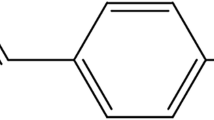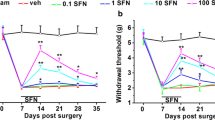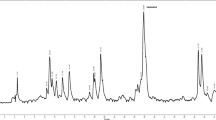Abstract
Background
Due to the complications related to the use of the current pharmacological approach for the alleviation of neuropathic pain, searching for effective compound with fewer complications is a requirement of the present era. It is well known that the pathophysiological mechanism of neuropathic pain is related to excessive inflammation in the nervous system. Hence, the present study focuses on whether the potential analgesic effects of Terminalia chebula (TC) extract are mediated by the changes in the protein expression of nerve growth factor (NGF) and nuclear factor-kappa B (NF-κB) in the brain in a rat model of sciatic nerve chronic constriction injury (CCI).
Method and Results
Neuropathic pain was induced by the left sciatic nerve CCI. Male Wistar rats were assigned to three groups: sham, CCI, and CCI + TC (40 mg/kg). Animals received either normal saline (1 mL) or the aqueous-alcoholic extract of TC (40 mg/kg) for 30 days via gavage needles once a day. Cold allodynia and anxiety-like behaviors were examined one day before CCI surgery (day − 1), as well as days 2, 7, 14, and 30 following CCI. We also assessed the effects of the TC extract oxidative stress markers on day 30 following CCI. Moreover, a western blot analysis was performed on day 30 following CCI to evaluate the effects of the TC extract on the protein expression of NGF and NF-κB in the brain. Oral gavage of the TC extract significantly decreased cold allodynia on days 2 and 14 following CCI. Additionally, the CCI model of chronic pain significantly increased the protein expression of NGF and NF-κB in the brain on day 30 following CCI. Furthermore, the TC extract significantly decreased the protein expression of NGF and NF-κB in the brain. The TC extract also significantly increased the brain glutathione (GSH) content and decreased the malondialdehyde (MDA) content.
Conclusion
It is suggested that the analgesic effects of the TC extract are mediated by the suppression of brain NGF, NF-κB, and by its antioxidant activity in the brain following neuropathic pain in rats.








Similar content being viewed by others
Data Availability
The datasets used or analyzed during the current study are available from the corresponding author upon reasonable request.
References
Rezq S, Alsemeh AE, D’Elia L, El-Shazly AM, Monti DM, Sobeh M (2020) Thymus algeriensis and Thymus fontanesii exert neuroprotective effect against chronic constriction injury-induced neuropathic pain in rats. Sci Rep 10(1):1–5
Cohen SP, Mao J (2014) Neuropathic pain: mechanisms and their clinical implications. BMJ 348:7656–7656
Viswanath O, Urits I, Burns J, Charipova K, Gress K, McNally A (2020) Central neuropathic mechanisms in pain signaling pathways: current evidence and recommendations. Adv Ther 37(5):1946–1959
Ahmed AS, Berg S, Alkass K, Druid H, Hart DA, Svensson CI (2019) NF-κB-associated pain-related neuropeptide expression in patients with degenerative disc disease. Int J Mol 20(3):658
Dai WL, Yan B, Bao YN, Fan JF, Liu JH (2020) Suppression of peripheral NGF attenuates neuropathic pain induced by chronic constriction injury through the TAK1-MAPK/NF-κB signaling pathways. Cell Commun Signal 18(1):1–3
Üçeyler N, Rogausch JP, Toyka KV, Sommer C (2007) Differential expression of cytokines in painful and painless neuropathies. Neurology 69:42–49
Dos Reis RC, Kopruszinski CM, Nones CF, Chichorro JG (2016) Nerve growth factor induces facial heat hyperalgesia and plays a role in trigeminal neuropathic pain in rats. Behav Pharmacol 27(6):528–535
da Silva JT, Evangelista BG, Venega RAG, Seminowicz DA, Chacur M (2019) Anti-NGF treatment can reduce chronic neuropathic pain by changing peripheral mediators and brain activity in rats. Behav Pharmacol 30(1):79–88
Yang S, Huang Y, Ye Z, Li L, Zhang Y (2020) The efficacy of nerve growth factor antibody for the treatment of osteoarthritis pain and chronic low-back pain: a meta-analysis. Front Pharmacol 11:817
Xu L, Liu Y, Sun Y, Li H, Mi W, Jiang Y (2018) Analgesic effects of TLR4/NF-κB signaling pathway inhibition on chronic neuropathic pain in rats following chronic constriction injury of the sciatic nerve. Biomed Pharmacother 107:526–533
Zhao L, Tao X, Song T (2021) Astaxanthin alleviates neuropathic pain by inhibiting the MAPKs and NF-κB pathways. Eur J Pharmacol 912:174575
Ahmed S, Naved A, Khan RA, Siddiqui S (2015) Analgesic activities of methanol extract of Terminalia chebula fruit. J Pharm Pharmacol 6(12):547
Sireeratawong S, Jaijoy K, Khonsung P, Soonthornchareonnon N (2014) Analgesic and anti-inflammatory activities of the water extract from Terminalia chebula Rezt. Afr J Tradit Complement Altern Med 11(6):77–82
Panunto W, Jaijoy K, Soonthornchareonnon N, Lertprasertsuke N, Sireeratawong S (2010) Acute and chronic toxicity studies of the water extract from dried fruits of terminalia chebula rezt in rats. Int J Appl Res Nat Prod 3:36–43
Gupta A, Chandra pal V (2018) Pharmacological evaluation of memory enhancing activity of aqueous extracts of Terminalia chebula (Haritaki) in rats. World J Pharm Pharm Sci 7(10):1608–1620
Abraham A, Samuel S, Mathew L (2020) Phytochemical analysis of Pathyashadangam kwath and its standardization by HPLC and HPTLC. J Ayurveda Integr Med 11(2):153–158
Bennett GJ, Xie YK (1988) A peripheral mononeuropathy in rat that produces disorders of pain sensation like those seen in man. Pain 33:87–107
Mirasheh MH, Zohrehvand MR, Kazemi R, Bahari Z, Bahrami F, Jangravi Z (2020) The analgesic and anxiolytic activity of resveratrol mediated by different sub-types of α-adrenoceptors of anterior cingulate cortex following neuropathic pain in male rats. J Adv Med Biomed 28(129):183–190
Akçali D, Belen AD, Babacan A, Bolay H (2017) Nitroglycerin challenge induces lateralized headache in nasociliary nerve-ligated rats: implications for chronic migraine. Turk J Med Sci 47:681–688
Mei-Jing KO, Zhe XU, Yan-Yun LI, Yue-Yun LI, Yan LI, Jia-Xu CH (2018) Differentially expressed proteins in rat hippocampus after chronic immobilization stress and intervention using xiao yao san decoction. DCM 1(3):219–227
Aebi H (1984) Catalase in vitro. Methods Enzymol 105:121–126
Namadr F, Bahrami F, Bahari Z, Ghanbari B, Elahi SA, Mohammadi MT (2019) Evaluation of the effects of fullerene C60 nanoparticles on oxidative stress parameters in normal rats liver and brain. J Adv Med Biomed Res 27(124):8–15
Yazdanparast R, Bahramikia S, Ardestani A (2008) Nasturtium officinale reduces oxidative stress and enhances antioxidant capacity in hypercholesterolaemic rats. Chem Biol Interact 172(3):176–184
Moron MS, Depierre JW, Mannervik B (1979) Levels of glutathione, glutathione reductase and glutathione S-transferase activities in rat lung and liver. BBA 582(1):67–78
Alomar SY, Gheit RE, Enan ET, El-Bayoumi KS, Shoaeir MZ, Elkazaz AY (2021) Novel mechanism for memantine in attenuating diabetic neuropathic pain in mice via downregulating the spinal HMGB1/TRL4/NF-kB inflammatory axis. Pharmaceuticals 14(4):307
Kaushik AS, Strath LJ, Sorge RE (2020) Dietary Interventions for Treatment of Chronic Pain: Oxidative Stress and Inflammation.Pain Ther1–12
Afshari AR, Sadeghnia HR, Mollazadeh H (2016) A review on potential mechanisms of tTerminalia chebula in alzheimer’s disease. Adv Pharmacol Sci 8964849:2016
Prajapati S, Bhardwaj A, Gupta P (2020) Anatomical and phytochemical standardization of terminalia chebula and syzygium jambolanum: a highly used medicinal plant in India. Plant Cell Biotechnol Mol Biol 5:31–41
Singh MP, Sharma CS (2010) Pharmacognostical evaluation of Terminalia chebula fruits on different market samples. Int J ChemTech Res 2(1):57–61
Afshari AR, Sadeghnia HR, Mollazadeh H (2016) A review on potential mechanisms of Terminalia chebula in Alzheimer’s disease. Adv Pharmacol Sci 2016
Seo JB, Jeong JY, Park JY, Jun EM, Lee SI, Choe SS (2012) Anti-arthritic and analgesic effect of NDI10218, a standardized extract of terminalia chebula, on arthritis and pain model. Biomol Ther 20(1):104
Dai RP, Zhou XF (2014) Neurotrophins and Pain. In: Kostrzewa R (ed) Handbook of Neurotoxicity. Springer, New York, NY
Barker PA, Mantyh P, Arendt-Nielsen L, Viktrup L, Tive L (2020) Nerve growth factor signaling and its contribution to pain. J Pain Res 13:1223
Lippoldt EK, Ongun S, Kusaka GK, McKemy DD (2016) Inflammatory and neuropathic cold allodynia are selectively mediated by the neurotrophic factor receptor GFRα3. PNAS 113(16):4506–4511
Sobeh M, Mahmoud MF, Rezq S, Abdelfattah MA, Mostafa I, Alsemeh AE (2020) Haematoxylon campechianum extract ameliorates neuropathic pain via inhibition of NF-κB/TNF-α/NOX/iNOS signalling pathway in a rat model of chronic constriction injury. Biomolecules 10(3):386
Acknowledgements
This study was supported by Baqiyatallah University of Medical Sciences, Tehran, Iran. The present study was Ms.c thesis of Mostafa Haghani.
Author information
Authors and Affiliations
Contributions
Z.J. and M.H. carried out the study. M.J. interpreted the data, and drafted the manuscript. G.H.M. and Z.J. managed the data, carried out the statistical analyses, interpreted the data. M.J.B. revised the manuscript. E.S.S. carried out and interpreted HPTLC analyses. Z.B. helped design the study and revised the manuscript. All authors have read and approved the final version of the manuscript and agree with the order in which the authors are listed.
Corresponding author
Ethics declarations
Conflict of interest
The authors declare financial or non-financial conflict of interest.
Research involving human and animal rights.
The present study was an animal study. All experiments conducted in agreement with the National Institutes of Health Guide for Care and Use of Laboratory Animals, and was approved by the local ethical committee of Baqiyatallah University of Medical Sciences, Tehran, Iran (Ethical code: IR.BMSU.REC.1400.033).
Additional information
Publisher’s Note
Springer Nature remains neutral with regard to jurisdictional claims in published maps and institutional affiliations.
Electronic supplementary material
Below is the link to the electronic supplementary material.
Rights and permissions
Springer Nature or its licensor holds exclusive rights to this article under a publishing agreement with the author(s) or other rightsholder(s); author self-archiving of the accepted manuscript version of this article is solely governed by the terms of such publishing agreement and applicable law.
About this article
Cite this article
Haghani, M., Jafari, M., Meftahi, G.H. et al. Analgesic effects of Terminalia chebula extract are mediated by the suppression of the protein expression of nerve growth factor and nuclear factor-κB in the brain and oxidative markers following neuropathic pain in rats. Mol Biol Rep 49, 10457–10467 (2022). https://doi.org/10.1007/s11033-022-07870-8
Received:
Accepted:
Published:
Issue Date:
DOI: https://doi.org/10.1007/s11033-022-07870-8




